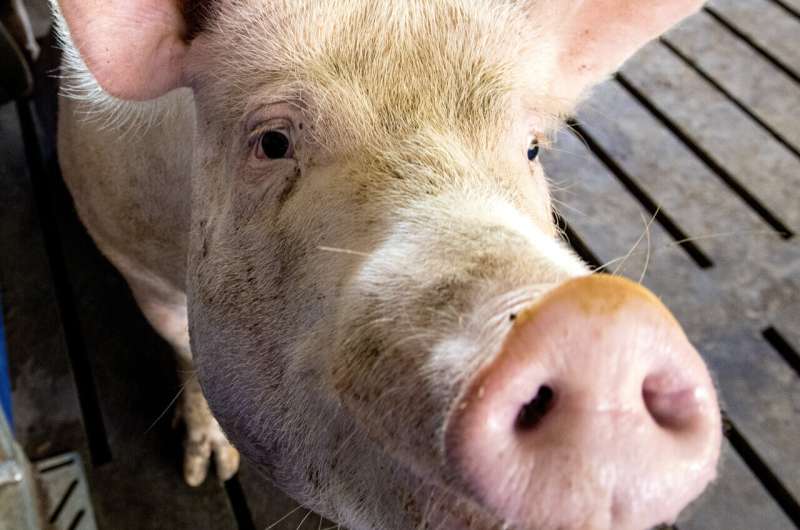This article has been reviewed according to Science X's editorial process and policies. Editors have highlighted the following attributes while ensuring the content's credibility:
fact-checked
proofread
Study shows slow-growth diet before breeding offers better long-range health in pigs

Borrowing a page from the dairy industry, researchers with the Arkansas Agricultural Experiment Station found that a slow-growth diet meant more piglets and healthier and longer-lived momma pigs.
Slowing weight gain for female pigs before breeding showed improvements in performance throughout four breeding cycles, according to Charles Maxwell, professor of animal science for the experiment station, the research arm of the University of Arkansas System Division of Agriculture.
"Scientists have done a wonderful job of increasing litter size and milk production so that our sow lines are essentially like Holstein cows and produce a huge amount of milk," Maxwell said. "But the difficulty you get into is, producing that amount of milk for that three-week period of time, we cannot get enough nutrients into the sows to keep them from losing weight."
A common practice in the industry has been feeding female breeding pigs the same as "terminal line" pigs before breeding. It leads to them being overweight at breeding age. Once they are bred and start lactating to feed their piglets, they lose weight because they eat less. That exacerbates the problem, Maxwell said.
Maxwell said that about half of the United States swine industry sows are replaced after lactation. The reasons for replacement include being overweight before breeding, poor fertility and lameness. Optimally, he said, a sow should be able to raise, or farrow, at least four litters of piglets to be profitable.
"They simply don't recycle and get bred back so they're replaced with another animal," Maxwell said. "The cost of this is the cost of the replacement animal. You could generate or breed more to make sure you're farrowing enough animals. However, you're still losing all the productivity you should be getting out of those animals."
Maxwell and TsungCheng Tsai, a swine nutrition researcher in the animal science department, joined three industry partners in developing a two-year study that mimics a practice done with dairy cows since the 1980s—slowing the growth rate of the female animals before breeding. A female pig is called a gilt before breeding, and a sow after it has produced a litter of piglets.
The study
Two diets were offered to young female breeding pigs to evaluate the dietary nutrient level. Low nutrient diets were formulated to reduce the gilt's lysine amino acid intake for a certain period. The diet included fiber with wheat "middlings" and dried corn distiller's grain with solubles to lower the energy density of the diets. A control group was provided a normal diet that exceeded industry standards.
The gilts on the low-nutrient diet were allowed to eat as much of their food as they wanted. At the end of their 26-week development period, the gilts fed the low-nutrient diet were about 15 pounds lighter than the normal-diet group. At the time of breeding, however, once placed on common diets, the average body weight of both groups was the same.
Although they started a little lighter, the group fed a low-nutrient diet during their development lost less body weight during lactation than the normal-diet group. When their piglets were weaned, the low-nutrient group also had a greater 10th-rib backfat thickness than sows fed a normal diet. Maxwell said that the greater 10th-rib thickness suggests that those sows used the nutrients they were getting better than those fed the normal diet as gilts.
"The measure of backfat is a relatively easy way to monitor the changes in body fat composition since much of the fat in swine is stored there," Maxwell said.
"Pigs consuming more dietary energy than is needed to meet their energy requirements store the excess as fat and this gain and loss of backfat can be monitored to reflect these changes. The procedure was standardized to sample the backfat at a specific location, the 10th rib, because of the variability of backfat thickness in different locations of the back."
Maxwell said the sows fed a low-nutrient diet as gilts did not reduce feed intake once they were bred and lactating like the other group. He added that slow growth also did not appear to impact their conception rate.
For each gilt in the study, the low-nutrient diets produced an average of 4.5 additional pigs at birth, 4.6 more pigs born alive, and 4.2 more pigs weaned. When measured over the four reproductive cycles, sows from the low-nutrient diet group farrowed 30 more litters, produced 380 more pigs born alive, and weaned 204 more pigs. A reproductive cycle is about 114 days.
"Feeding low-energy and reduced protein diets during gilt development can promote their ability to restore body condition during lactation, which boosted survivability throughout the four parity cycles and thus extended their longevity," Maxwell noted.
While Maxwell and Tsai think they are on the right track to mitigating the loss of sows, they are still looking for more ways to improve sow longevity.
"We're not there yet," Maxwell said. "Even with that treatment, we didn't have 100% survival. So, we still have a lot of questions to minimize the loss."
Sow farm concept
A rapidly growing component of swine production in Arkansas and across the South has been sow farms producing "feeder pigs" for shipment to the Midwest to continue raising or finishing. Arkansas has refined the "sow farm concept," Maxwell explained, to have much of the state's sow farm production involved with developing replacement gilts to supply the swine industry with high-health replacement females. Maxwell noted that this concept has evolved because Arkansas is relatively free of significant swine diseases found in the Midwest.
Provided by University of Arkansas System Division of Agriculture




















